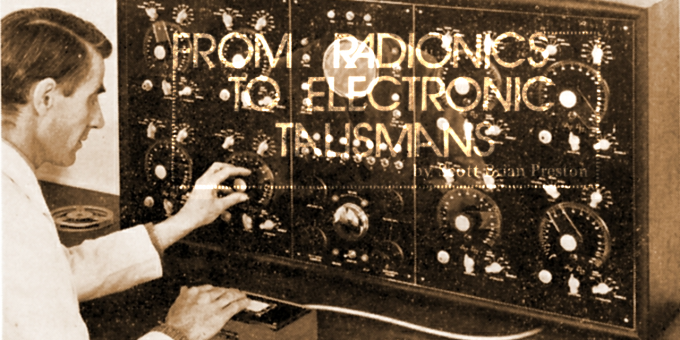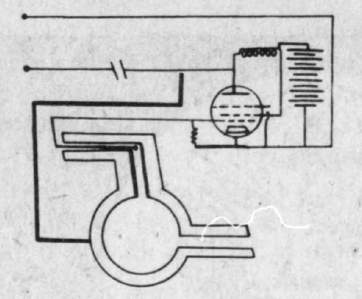
IX
Electronic Talismans
Witch doctors and magicians have supplied us with odd formulae to do many of the same things that radionics is involved in and much more. Magical processes promise wealth, romance, high adventure, the knowledge of buried treasure, etc. — all you have to do is figure out how a talisman really works.
Many popular books on magic pass off a talisman as a focal point for an idea or emotion. The authors claim that it is something you “put your faith in” or something that makes you feel more confident. I cannot argue with that; the act of belief does cause a change in an individual; a feeling of confidence can help one over rough spots. But the effect of a talisman should not depend entirely on the faith one has in it.
A recent book on magic called Magic: An Occult Primer by David Conway addresses itself to part of this problem:
The real magical talisman can be said to resemble a self-recharging battery. At the time of its preparation a propitious combination of angelic and planetary influences endows it with a specific type of magical energy. The exact nature of this energy will depend on the magician’s reasons for wanting the talisman, but once the energy has been acquired, or, to put it another way, once the talisman has been “charged,” it will proceed on the principle of universal sympathy to attract a flow of similar energy from the universe. This means that while a talisman is using up energy in furthering the cause to which it was dedicated, it is also drawing into itself sufficient new energy to continue that function.
Most books tell you this much and not much more. But, if you are to be really successful, what is the best way to construct your talisman so that it will hold a charge, either eloptic, psychic or electronic?
Abrams discovered that a piece of paper can retain “human energy” for several hours and can still cause the expected stomach reflex. A Leyden jar can also be used to store this energy a while longer. If this is so, then a capacitor of some sort would be in the interests of the talismanic magician. Capacitors, in all sizes, can be purchased or made for minimal fees. How intensely the talisman would work might depend on its ability for capacitance and the amount of “energy” the magician can “will” into it.
A type ofcapacitor which I have found useful for simple talismans is a variation of Reich‘s capacitor. An orgone capacitor consists of several alternating layers (the more layers, the more power) of organic and metallic materials (cardboard and aluminum or sheet metal). A layered object with metal on both sides should build up a tremendous orgone capacitance somewhere in the center. This charge will be drawn in especially powerfully when the object is wrapped in linen.
Once this capacitor or storage cell is made, the magician or hobbyist must find a way to release the energy to radiate and perform some function — otherwise it is useless. That’s the trick. It is likely that the thought form a magician puts behind the energy in any talisman will act as a guiding principle, but if this thought is not well established, the energy could be used for one purpose as well as another. If all energies are mindless radiations, then storing them up and releasing them without a preplanned broadcast frequency is just static. A shape and direction should be found to put the force in.
This is where designs and sigils come in. The geometries and the correspondences have been handed down for centuries with a lot of mumbo-jumbo about what they are. Sigils might really just be circuits. Circuits are shapes which direct and alter the characteristics of an energy flow. In conventional electrical circuits, the shapes have tubes, transistors, resistors and capacitors to further change the characteristics of the energy flow. But, in radionics and possibly in talismans, these shapes just need to be drawn in order to work.
 Fig. 3 — An abstract drawing of the Hieronymus machine, which is supposed to work from a mere copy of the design itself. A number of people have been able to detect the differences in metals by attaching this drawing to some dials and a detector plate.
Fig. 3 — An abstract drawing of the Hieronymus machine, which is supposed to work from a mere copy of the design itself. A number of people have been able to detect the differences in metals by attaching this drawing to some dials and a detector plate.
It was found that many radionic circuits work whether they are plugged into a power source or not. The tubes could work cold and still amplify the radiations; the only stipulation was that the circuit had to be intact and not short-circuit itself. Then it was found that certain radionic machines, like the Hieronymus mineral analyzer, could work from the schematic diagram! But still, the circuit had to be intact and the drawing had to be done in an electrically conductive ink — India ink worked quite well in these case. India ink, the most popular ink recommended for talismans, is electrically conductive, since it is made with particles of iron.
John Campbell started an underground fad back in the ’50‘s when he found that a drawing of the Hieronymus machine worked. Working diagrams could be made much more abstract than the original schematics; only the general electronic purpose had to be represented.
Campbell placed one of the diagrams inside a box and connected it to the rubbing plate and the resistor dial. He asked subjects to operate the “machine” and found that nearly nine out of twelve people could operate the drawing. He describes one such experiment to analyze lead (see Fig. 3):
When Dr. Gunther first saw the device, he knew I’d been working with the Hieronymus machine, and was told only that this was a simplified and improved version. He tried it, and got the 45 response.
Then he looked away, turned the dial well back toward zero, and retuned. Forty-five again. Again he turned the dial back, and tuned blindly; 45. Then I opened the box and showed him what was inside. After considerable discussion centering around “fantastic” and “unbelievable,” we put it back together, and he tried tuning again. He got 45 again.
Several magicians that I know of have been using this radionic concept in designing talismans for years. Some designs are cut into circuit boards and include satellite photos of propitious planets. When some great power is needed, full amplifiers are set up and turned on.
 Fig. 4 — The sigil of the demon Forneus, taken from the Lesser Key of Solomon. It can be noted how strongly this design resembles an electronic diagram. Other sigils are less “electronic” in design but may, nevertheless, be circuits of an unknown nature. Forneus is supposed to give the magician the ”knowledge of foreign languages and of arts and science,” a must for the liberal arts major, but how this design accomplishes this and whether the magician can be harmed are matters for curious speculation.
Fig. 4 — The sigil of the demon Forneus, taken from the Lesser Key of Solomon. It can be noted how strongly this design resembles an electronic diagram. Other sigils are less “electronic” in design but may, nevertheless, be circuits of an unknown nature. Forneus is supposed to give the magician the ”knowledge of foreign languages and of arts and science,” a must for the liberal arts major, but how this design accomplishes this and whether the magician can be harmed are matters for curious speculation.
The surprising similarity of the goetic designs from The Lesser Key of Solomon to electronic circuitry can be noted. Since radionic drawings can be very abstract, some of the more bizarre shapes may direct energy in some way unthought of by traditional electronics. Some of the “entities” represented are professed to give outlandish abilities such as instant knowledge of foreign languages. Others claim to be able to locate buried treasure; perhaps some form of radionic dowsing can do just that, but it has yet to be developed. Whether these goetic designs really put one in touch with demonic entities or whether they are circuits remnant from some antediluvian electronics book is anyone’s guess. Maybe your television works because there are spirits in it!
From “Gnostica News” No. 41 February/March 1977 (Volume 5 Issue 5)



